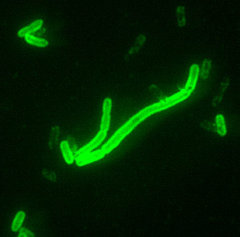Yersinia pestis
Yersinia pestis bacterium, belonging to the family Enterobacteriaceae. It is the infectious agent of bubonic plague, and can also cause pneumonic plague and septicemic plague. All forms have been responsible for enormous mortality in many fearsome epidemics throughout the history of mankind (without treatment, patients with the bubonic form die, and almost 100% with the pneumonic form), such as the Great Plague and the Black Death, the latter of which accounted for the death of approximately 25% of the European population. The role of Y. more...
Pestis in the Black Death is today highly debated amongst historians, as scientific evidence is pointing away from it as the cause.
The genus Yersinia is Gram negative, bipolar staining coccobacilli, and, similarly to other Enterobacteriaceae, it has a fermentative metabolism. Yersinia pestis produces a antiphagocytic slime. The organism is motile when isolated, but becomes nonmotile in the mammalian host.
History
Y. pestis was discovered in 1894 by Swiss/French physician and bacteriologist from the Pasteur Institute, Alexandre Yersin, during an epidemic of plague in Hong-Kong. Yersin was a member of the Pasteur school of thought. Shibasaburo Kitasato, a Germany-trained Japanese bacteriologist who practiced Koch's methodology was also engaged at the time in finding the causative agent of plague. However, it was Yersin who actually linked plague with Yersinia pestis. This was originally called Pasteurella pestis, and was renamed after Yersin in 1967.
Pathogenicity and immunity
Pathogenicity is due to two antiphagocytic antigens, named F1 and VW, both required for virulence. They are produced by the bacterium at the temperature of 37°C, so this explains why insects, such as the flea, harbor non-virulent bacteria. Furthermore, Y. pestis survive and produce F1 and VW antigens within blood cells such as monocytes, but not in polymorphonuclear neutrophils. Natural or induced immunity is achieved by the production of specific opsonic antibodies against F1 and VW antigens. They induce phagocytosis neutrophils.
There is a formalin-inactivated vaccine available for adults at high risk, but it is not very effective and may cause severe inflammatory reactions. Experiments with genetic engineering of a vaccine based on F1 and VW antigens is underway and shows great promise.
Genome
The genome of the CO92 strain obtained from clinical isolate from the USA was recently sequenced. The chromosome sequence is 4,653,728 base pairs long. Like its cousins Yersinia pseudotuberculosis and Yersinia enterocolitica, Y. pestis is host to the plasmid pCD1. In addition, it also hosts two other plasmids, pPCP1 and pMT1 which are not carried by the other Yersinia species. Together, these plasmids, and a pathogenicity island called HPI, encode several proteins which cause the pathogenicity for which Y. pestis is famous. Among other things, these virulence factors are required for bacterial adhesion and injection of proteins into the host cell, invasion of bacteria into the host cell, and acquisition and binding of iron harvested from red blood cells. Y. pestis is thought to be descendant from Yersinia pseudotuberculosis, and is different only because of the presence of the virulence plasmids.hi
Read more at Wikipedia.org



